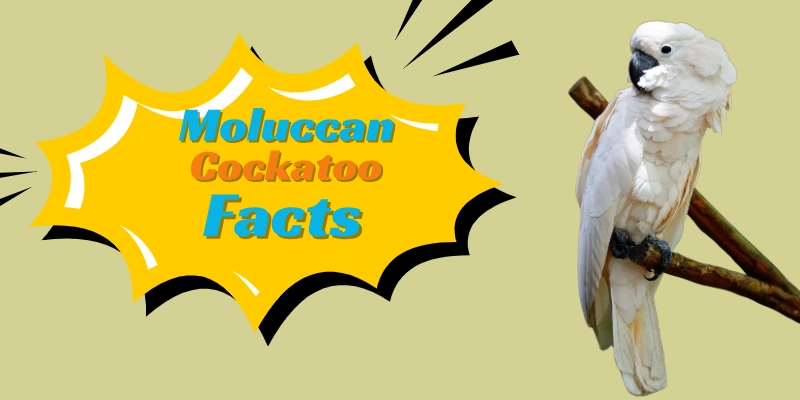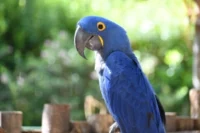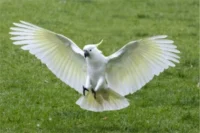Moluccan Cockatoo Facts – Behavior & Lifespan
Published: 21 Jun 2025
The Moluccan Cockatoo is one of the most striking and affectionate parrots. Native to the Indonesian Moluccas, this large white-pink bird is famous for its dramatic red crest and emotional intelligence.
They’re loud, loving, and highly social, making them unforgettable in both the wild and captivity.

If you’re curious to learn more, the following Moluccan Cockatoo facts are grouped into key categories to help you understand this incredible bird better.
Categories & Facts
Here are the Moluccan Cockatoo parrot facts by:
1. Appearance & Physical Traits
2. Habitat & Distribution
3. Diet & Feeding
4. Behavior & Intelligence
5.Reproduction & Lifespan
6. Conservation Status
1. Appearance & Physical Traits
Let’s start with how this stunning bird looks—you’ll see why it turns heads everywhere.
- Grows up to roughly 20 in (50 cm) in length with a ~2 ft wingspan.
- Weighs between 27–33 oz (775–935 g), with females slightly larger.
- Plumage is primarily white‑pink with a peachy glow; underwings/tails show yellow tones.
- Crest is salmon‑pink to flamingo‑colored—raised during emotion displays.
- Has powerful, black beak and zygodactyl feet—two toes forward, two back.
2. Habitat & Distribution
To understand the Moluccan Cockatoo better, it helps to know where they come from and the kind of environment they thrive in.
- Endemic to the Seram and Ambon islands of Eastern Indonesia.
- Lives in lowland forests, rainforests, mangroves, and coastal woodland.
- Usually found below 1000 m elevation.
- They naturally form flocks but breed in monogamous pairs.
- Also known as crop pests; they chew through young coconuts.
3. Diet & Feeding
What they eat plays a huge role in their health and behavior—here are the key facts about their diet.
- Eats seeds, nuts, fruits, coconuts—and even insects.
- Uses one foot to hold food and the other to tear it apart.
- Requires a varied, protein-inclusive diet—can get anemia without insects.
- In captivity, pellets mixed with fresh fruits, nuts, and foraging toys are recommended.
- Wild foraging can last all day, mimicked in captive environments .
4. Behavior & Intelligence
These birds are not just beautiful—they’re also known for their complex behaviors and high intelligence.
- Exceptionally social and affectionate—often described as “velcro birds”.
- Can become obsessive—crave constant attention; risk of behavioral issues when lonely .
- Screeching calls can reach very high volumes and occur day or night.
- Capable mimics, though they often scream words loudly rather than speak softly.
- Highly intelligent—can outsmart cages, require lots of mental stimulation.
5. Reproduction & Lifespan
Here’s what you need to know about how long they live and how they reproduce, both in the wild and in captivity.
- Reach sexual maturity between 3–7 years.
- Breed seasonally (typically March–September), laying 1–2 eggs per clutch .
- Both parents share incubation duties (~28 days) .
- Juveniles may stay with parents up to one year.
- Lifespan ranges between 60–80 years, with some living up to 100.
6. Conservation Status
Moluccan Cockatoos are sadly facing serious threats in the wild—these facts explain their current conservation status.
- Classified as Vulnerable (IUCN) due to habitat loss and trapping.
- Wild population may be fewer than 2,000 individuals remaining.
- Over 6,000 were captured annually in past decades.
- Listed under CITES Appendix I since 1989 to restrict trade.
- Conservation efforts include protected habitats and reduced trapping .
Caring for a Pet Moluccan Cockatoo
If you’re considering bringing one home, here’s what it really takes to care for a Moluccan Cockatoo.
- This species demands extensive attention—best for experienced owners.
- They need large, sturdy cages and plenty of exercise space.
- Mental enrichment is vital—daily toys, puzzles, foraging, and interaction.
- Neglect can lead to feather-plucking, depression, and self-harm.
- Be prepared for lifelong commitment—up to 80+ years of care.
Conclusion
So guys in this article we have discussed Moluccan Cockatoo Facts in great detail. The spectacular Moluccan cockatoo is more than just a beautiful bird—it’s incredibly emotional, intelligent, and demanding. From its stunning salmon‑pink crest to its lifelong devotion, this species captures hearts easily but also requires serious dedication. Whether you’re exploring their wild habits or considering them as a pet, understanding their needs is key to appreciating these extraordinary companions.
So, thinking of welcoming one or just fascinated by them?
Let these Moluccan Cockatoo facts guide your next step read, learn, and share the love for this amazing bird!
References
The following references have been gathered from various reliable online sources to support the information presented above.
1.https://en.wikipedia.org/wiki/Cuban_amazon?utm_source=chatgpt.com
2.https://animaldiversity.org/accounts/Amazona_leucocephala/?utm_source=chatgpt.com
3.https://en.wikipedia.org/wiki/Cuban_amazon?utm_source=chatgpt.com
4.https://animaldiversity.org/accounts/Amazona_leucocephala/?utm_source=chatgpt.com
5.https://parrots.org/encyclopedia/cuban-amazon/?utm_source=chatgpt.com
6.https://www.exmoorzoo.co.uk/animal/cuban-amazon/?utm_source=chatgpt.com
7.https://parrots.org/encyclopedia/cuban-amazon/?utm_source=chatgpt.com
8.https://susanclubb.com/knowledge-center/bird-species-profiles/14-amazons/26-cuban-amazon?utm_source=chatgpt.com
9.https://www.exmoorzoo.co.uk/animal/cuban-amazon/?utm_source=chatgpt.com
10.https://theparrotsocietyuk.org/site/index.php/parrot-information/articles/articles-on-parrot-species/the-cuban-amazon/?utm_source=chatgpt.com
❓ Frequently Asked Questions (FAQs)
Still curious? Here are the most frequently asked questions people have about Moluccan COckatoo and their lifestyle.
Moluccan Cockatoos can be great companions for experienced bird owners. They are affectionate and intelligent but require a lot of attention and time. Without proper care, they may develop emotional or behavioral problems.
They can live anywhere between 60 to 80 years, and some even reach over 100 with excellent care. This makes them a lifelong commitment. Many outlive their original owners, so long-term planning is essential.
These birds naturally use loud calls to communicate across dense forests. In captivity, they may scream for attention, when bored, or if they feel stressed. Regular mental stimulation and social interaction help manage this behavior.
Yes, they are classified as “Vulnerable” by the IUCN due to habitat loss and illegal trapping. Their wild population is estimated to be below 2,000 individuals. Conservation efforts are ongoing to protect and restore their numbers.
In the wild, they eat seeds, fruits, nuts, coconuts, and some insects. In captivity, a balanced diet includes pellets, fresh produce, and occasional protein sources. They enjoy foraging and need variety to stay healthy.
Yes, they can mimic words and sounds, but not all are strong talkers. They are more known for their volume than clarity. Training and repetition from a young age can help them learn more phrases.
They thrive on daily interaction and emotional bonding. These birds need 3–5 hours of out-of-cage time with their owner each day. Without enough attention, they may become depressed or destructive.
They can be territorial and may not mix well with other birds or animals. Introductions should be slow, careful, and always supervised. Some individuals may be more social, depending on their upbringing.
In many places, it is legal but heavily regulated. They are protected under CITES, so permits may be required depending on your country or state. Always research your local laws before purchasing or adopting one.
Support reputable conservation organizations working in Indonesia and globally. Avoid supporting illegal bird trade and choose ethical breeders or rescues. Raising awareness and educating others can also make a big difference.

- Be Respectful
- Stay Relevant
- Stay Positive
- True Feedback
- Encourage Discussion
- Avoid Spamming
- No Fake News
- Don't Copy-Paste
- No Personal Attacks

- Be Respectful
- Stay Relevant
- Stay Positive
- True Feedback
- Encourage Discussion
- Avoid Spamming
- No Fake News
- Don't Copy-Paste
- No Personal Attacks





